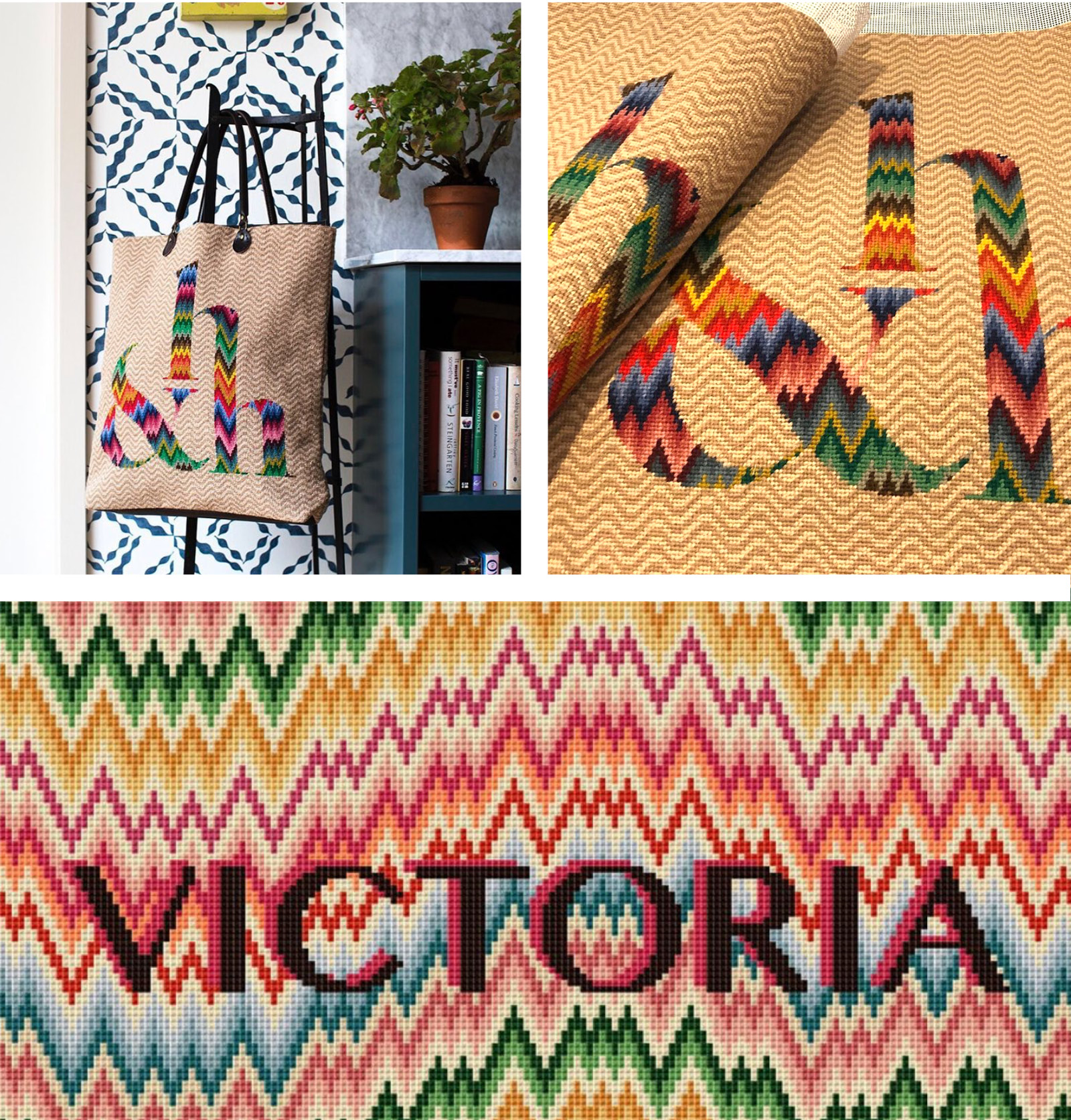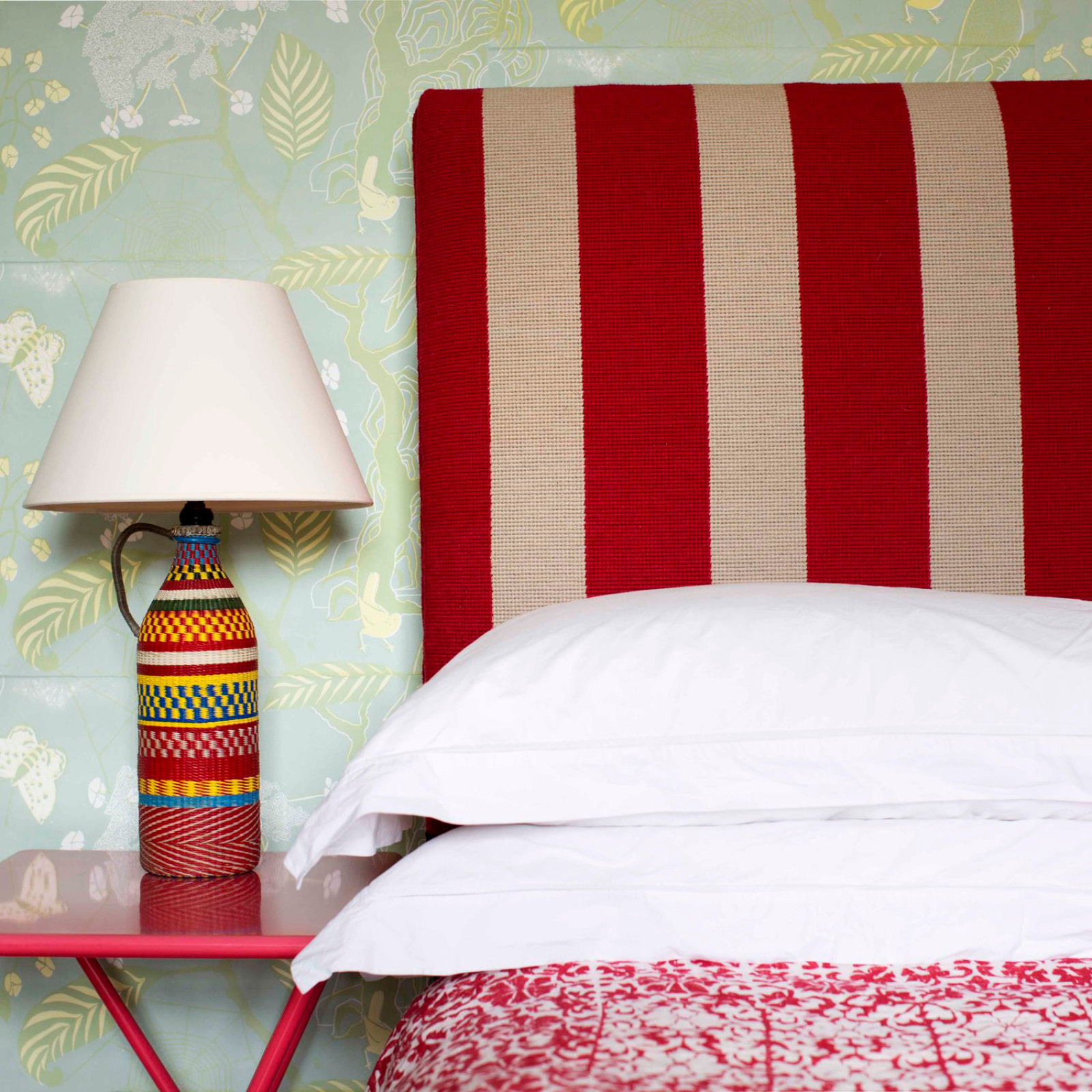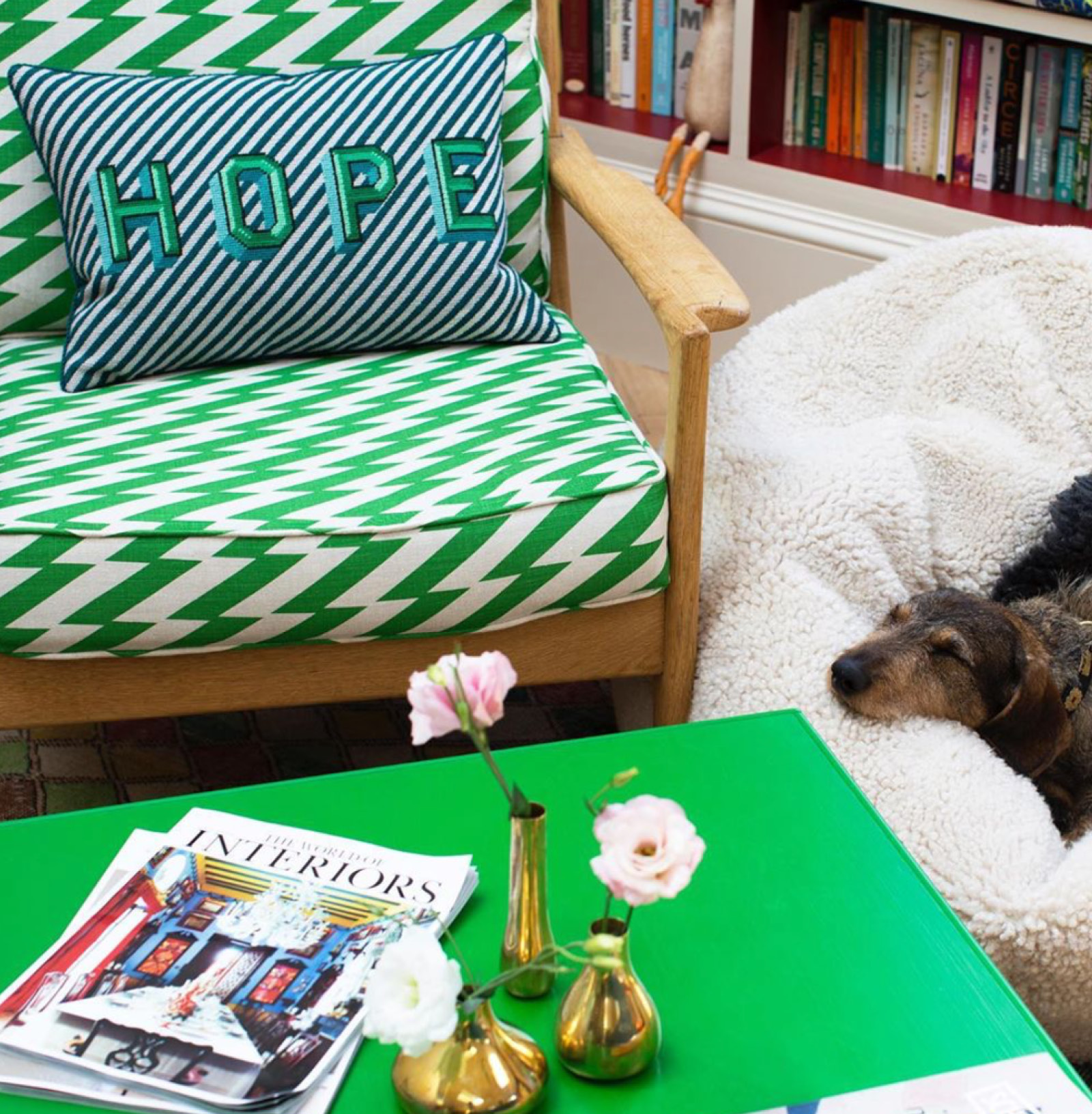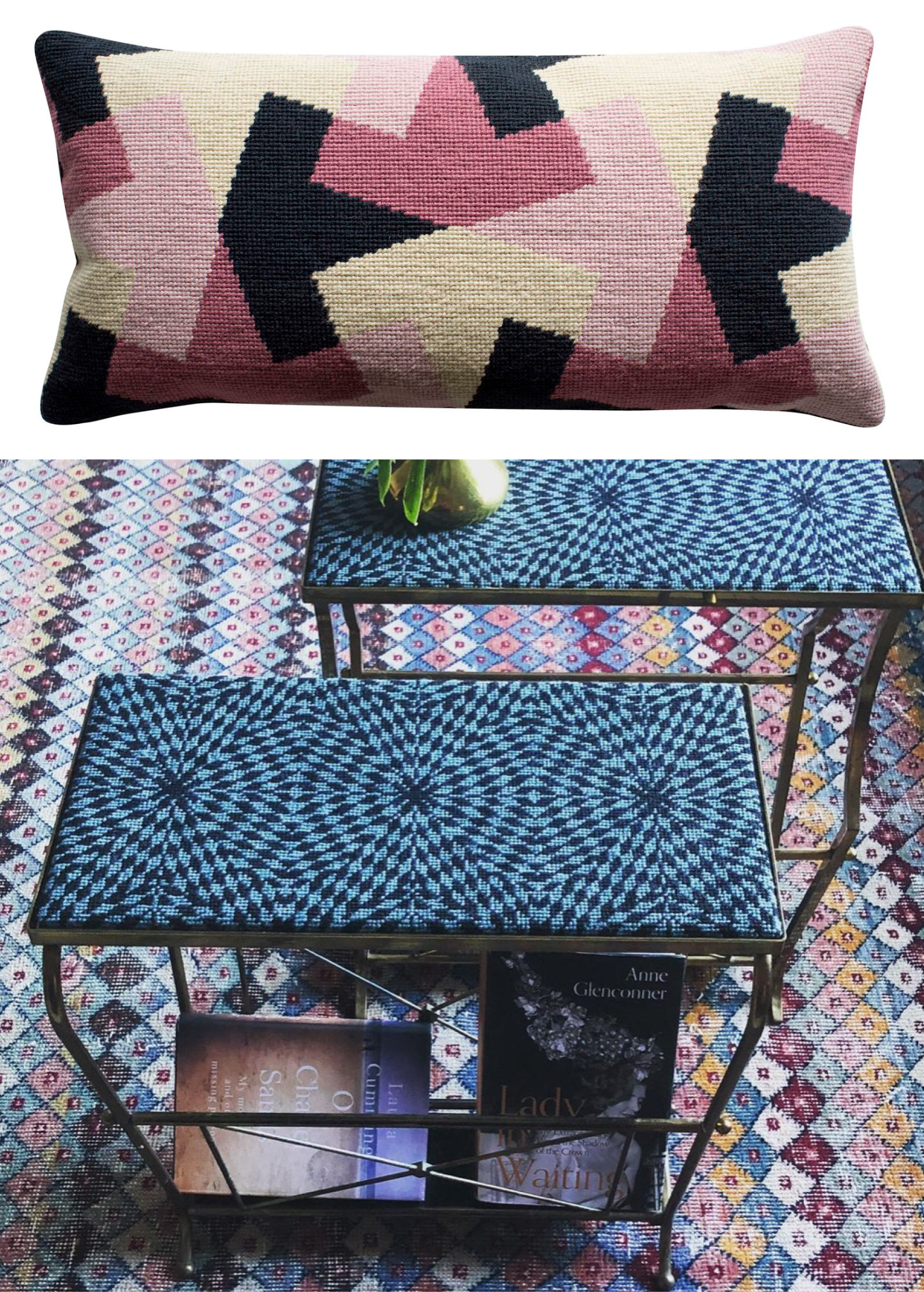
As a designer and lover of all things beautiful, my travel itineraries always carve out time for shopping. In London, I’ll visit those glamorous iconic department stores and arcades that are jotted on every American’s bucket list: Harrod’s for the food halls, Harvey Nichols for well edited original pieces, Liberty London for hip floral accessories for the home, and the famed Portobello Road for antiques of all kinds.
But what’s especially inspiring, are the discoveries that I make at smaller shops, and one that caught my eye on my last trip across the pond was Hunt & Hope (@huntandhope). This needlepoint specialty shop offers bespoke designs that modernize a classic and ancient form of stitching. From canvases with monograms that will be stretched over an antique footstool, to a chic avant-garde graphic that’s sandwiched between two sheets of acrylic, the designs are fresh and current. I spoke with founders and owners Emmie Hunt and Izzy Hope. Their passions to revive this textile has resulted in a healthy following. I hope that you’ll learn about needlepoint from my conversation with them. Enjoy!

What led the two of you to start this business?
Izzy and I have known each other since our early 20s. That was 30 years ago, so you can do the math! We were at different Universities, she at Cambridge, and me at Darwin. She studied to become a lawyer and I studied to become a teacher. I eventually ended up working as a headhunter. My hours were long, and Izzy’s job didn’t necessarily bring her the level of joy that she wanted. We were both in places where we didn’t want to be, and eventually both left our positions. I was at home attending to my boys, and Izzy went to India, where she went to investigate the extraordinary embroidery of India. She immersed herself in needlepoint and launched kits that were so very different from what else was on the market at that time. They were like oil paintings, very tonal and special. When she realized that her passion for needlepoint was deep, she went off to the Chelsea Art College and learned to draw and how to operate CAD. One morning when we were together, we chatted and decided to launch a business of our own.
What are your personalities? Are you similar in the way you operate?
We wanted to do something together, but we are very different. I’m macro, Izzy is micro. I like big bold colors, and she loves neutrals. We were so inspired and excited to begin that we just started. There wasn’t time for fear. It felt intuitive and a massive opportunity, so we agreed to jump in to see what would happen. Decorex 2017 was our official launch and market research. People who stopped by our stand were so enthusiastic and supportive.

Social Media plays such an integral role in small businesses. How did it help yours?
We have Instagram to thank for spreading our word. Instagram is such a friendly platform, and a much-needed voice for us at this point. We had a lot of press when we launched in 2017. At that time, the magazines came to us, and we had to do very little. Because our clients come first, we rely on Instagram for marketing and public relations. It’s truly been transformational. There’s also a level of reassurance that it provides. For instance, tomorrow I’ll post something that we want to push forward. Something that has a little edge. Our followers will let us know if we should move forward with something. They are honest and genuine. It’s market research 24/7. I don’t engage in social media a whole lot personally, but for a small business, I can’t find fault.
It’s funny to ask about trends in a technique as old as needlepoint. But are there trends?
Monograms are very much of the moment. They’ve always been around and are so appealing to our clients in the U.S. They are more enthusiastic about monogramming. It’s just a cultural thing. Our top five products are cushions, works framed in acrylic to be hung on walls, Christmas stockings, footstools, and chair seats.
Keep in mind, we have an aesthetic to which we are committed. Our objective was to revive needlepoint and inject this ancient craft with wonderful colors and contemporary patterns that made it compatible with a modern interior. Our tagline is “modern design, traditionally stitched.” We defined our aesthetic, and it doesn’t include quaint, old-school flowers or commercial Santas. Our technique isn’t new, but the designs are. We want each client to have something special, custom, and unique to them.

What is your process?
Most clients come to us with some inspiration, and then we ask loads of questions about colors and styles. We request pictures of the other elements in the space where the piece is going so we clearly understand the palette. We make samples, and once the green light is given, we send the wool to our team in Madagascar, where we have 35 embroiderers. We constantly communicate with our clients through imagery so that there are no surprises. They can see their piece being crafted.
There is so much time that comes with something that is hand-crafted. How do your clients react to a long process when we live in a world that is used to getting what they want quickly, sometimes instantly?
I have teenage sons who’ve grown up with Amazon. There are times when they wonder why something doesn’t arrive in 24 hours or less. How much faster can deliveries get? Needlepoint is the exact opposite. It’s a process and one that takes time. Our goal is to make “slow” a good word. We really can’t speed up the process, and we don’t apologize for that. It’s a unique strength to work with a craft that cannot be rushed.
That slow process isn’t spent for no reason. What we create will last for generations. It’s one of the most robust textiles out there, that’s why you can still source 18th century tapestries. Our lead time is 18 weeks. I don’t think that’s bad for original artwork. Our canvases are stitched in Madagascar, where the artisans are properly paid. A well-trained artist completes between 1000 and 1500 stitches per day. That’s a fair number, but one that would seem difficult for someone who has never stitched before. When the stitchers’ hands ache, they stop, and that’s the way it should be. That’s why it takes time. An average chair seat is 35,000 stitches. We are only as good as our last commission, so a slow and thoughtful system is good.

During lockdown, so many people examined how they spend their time, and realized that they had a creative “bug.” Has this year driven awareness to your business?
Definitely. I found that during lockdown we received more emails than ever asking for kits, which we do not offer. We were inundated. So much of lockdown was about screens, zoom calls, emails, big chunks of the day devoted to communication performed on-screen. Activities such as gardening, painting, needlepoint, don’t invite phones and laptops. Those activities are so therapeutic. There is something about the repetition, whether its gardening or forming clay into a pot or stitching. It’s not about needlepoint specifically, rather any art form that provides an effective way to calm one down and make one feel better. That is why we have survived this year.
We are three years in now and believe that it is too early to diversify. We want to be known as a business where every single commission is bespoke. Kits will be done eventually, but right now, we are plenty busy with the commissions. Everything that we stitch is made to order. Every commission is unique. We don’t sell in quantity, and that adds to the quality and value of each piece.

Now that you are three years into this, what does embroidery mean to you?
It means that you HAVE to stop the phone time. When I see what my screen time is for the day, I oftentimes shake my head. It’s just too much. At some stage, one has to stop and do something else. It doesn’t matter what the art form is, but it’s important to do something that doesn’t allow devices to dominate your life. Needlepoint is my passion. Our business feels small, special, and personal. And that’s the way we want it to stay for now.
It’s not like we’ve invented anything. All we’ve done is brought in color and design to needlepoint so it has a modern edge. Our aim was very simple. Give it the exposure that it deserves. And we’ve done that.


